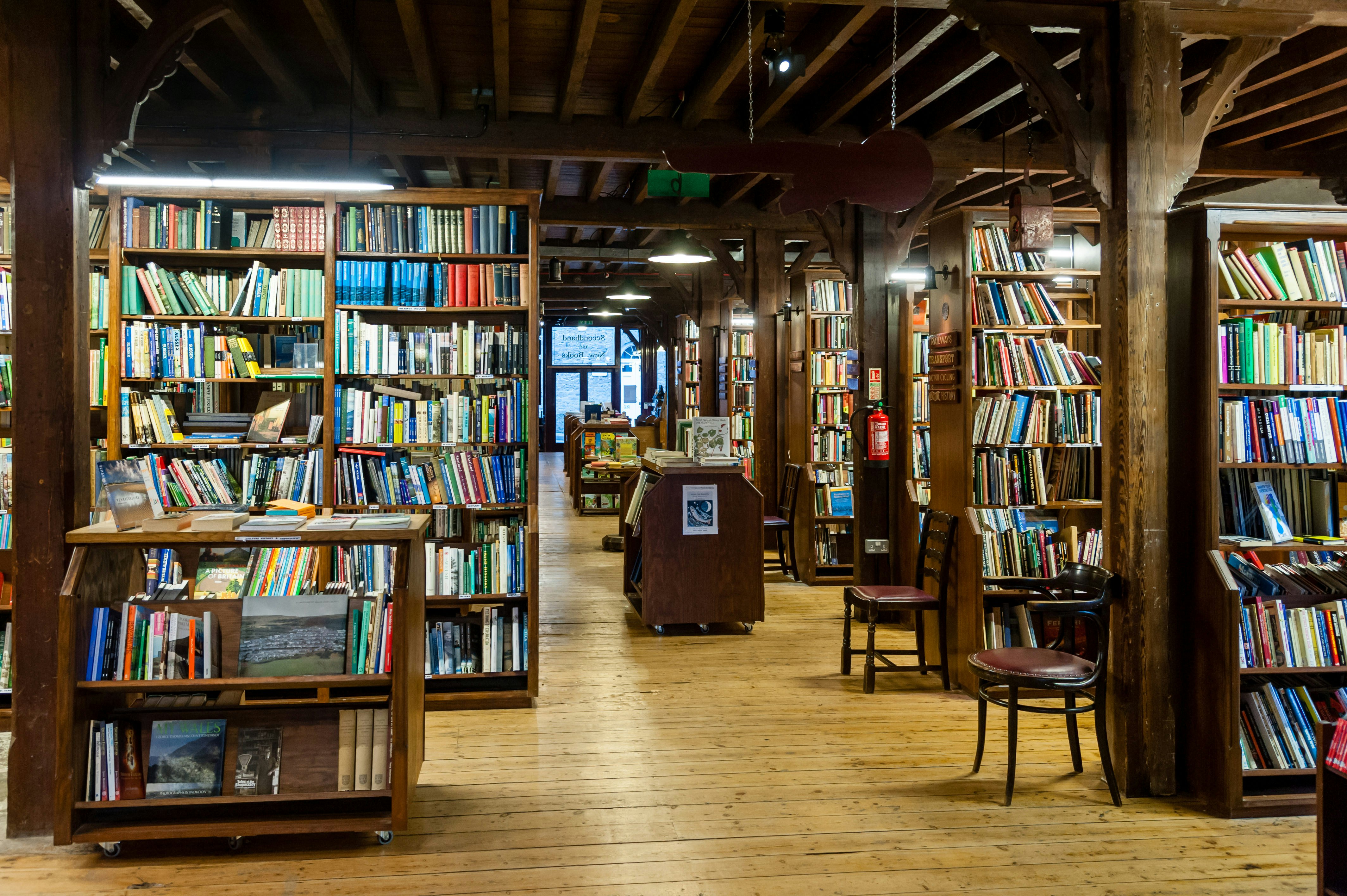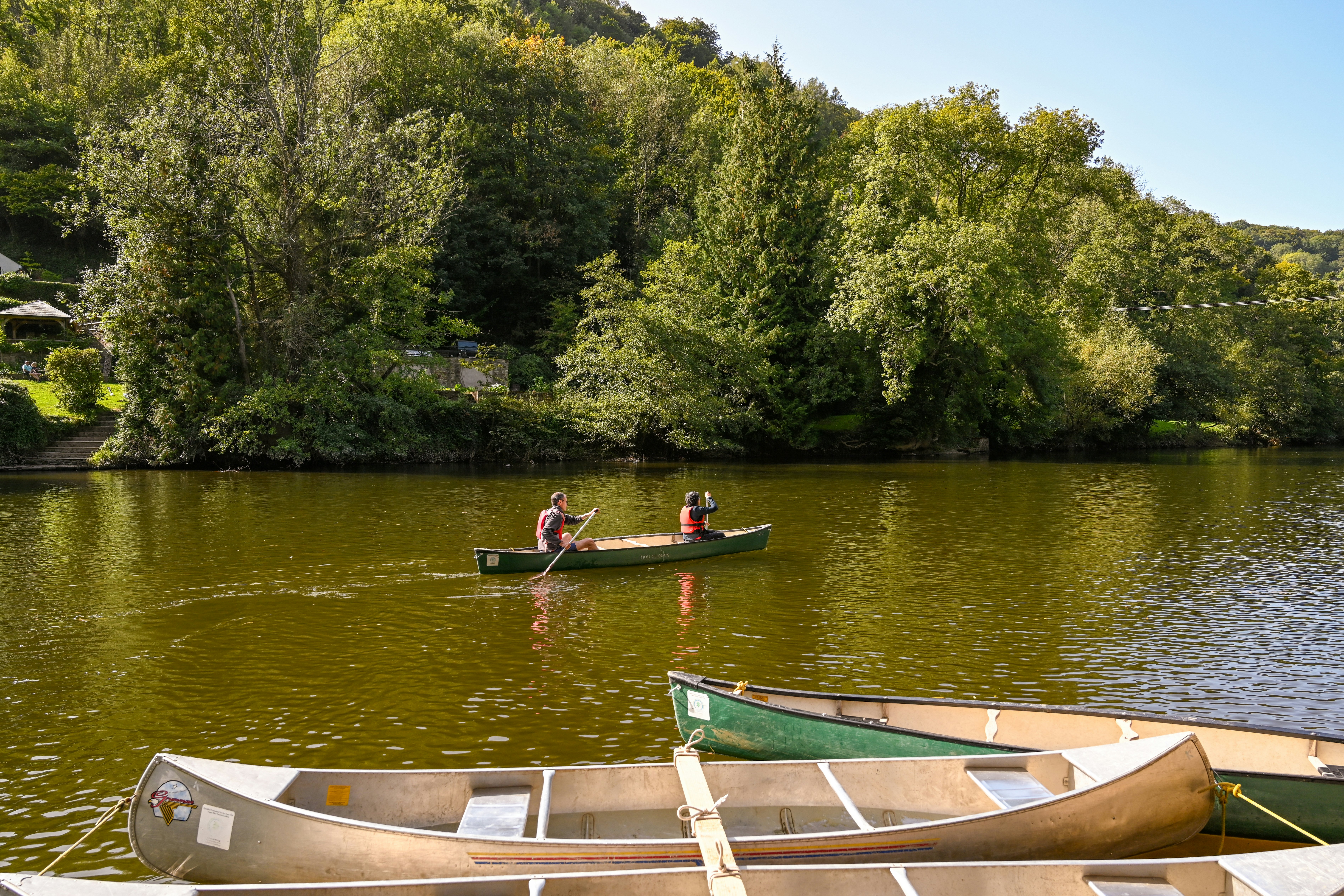
Famous for its bookstores, Hay-on-Wye is also a great base for exploring the Welsh borders. P A Thompson/Getty Images
Straddling the banks of the River Wye, just inside the border between England and Wales, Hay-on-Wye, or Y Gelli Gandryll in Welsh, will steal your heart with its location before sending your soul winging straight to book heaven.
This handsome Georgian market town exploded onto the literary scene in the 1970s when Richard Booth – the self-proclaimed "King of Hay" – put the village on the map as the center of the secondhand book trade. Today, the town's narrow sloping lanes are peppered with bookshops, antique shops, galleries, craft shops, delis and artsy cafes.
This newfound literary fame was the impetus for the launch of the Hay Festival of Literature & Arts. Founded in 1988, it has grown in stature each year to embrace all aspects of the creative arts. Even outside festival time, its alternative ambience lingers.
Hay is a place to browse, dream, philosophize and crack the spine on a musty classic novel. Beyond browsing bookstores, here are the best things to see and do near this picturesque village on the Welsh borders.

1. Browse, buy and read books in Hay-on-Wye
Famously known as the town of books, Hay-on-Wye has more than 20 bookshops, some with particular specialties such as antique books or old-map books. There's even one shop titled “Murder and Mayhem.”
The town gained global recognition in the 1960s, when larger-than-life bookseller Richard Booth opened his first secondhand bookshop here, declaring Hay the world’s first “Book Town.” In the process, Hay metamorphosed from a declining border town into a literary haven. Today, Hay’s bookshops offer a quiet resistance to digital culture, celebrating the tangible joy of printed books in a picturesque, literary landscape.
In 1961, after graduating from Oxford, Booth bought Hay's old fire station and turned it into the first of many secondhand bookshops. Next, he established the world's largest bookshop in Hay's old cinema, before opening Booth Books and Hay Castle Books, inspiring other booksellers to follow suit.
Planning tip: Richard Booth passed away in 2019, but his legacy lives on at Richard Booth's Bookshop on Lion St.
2. Eat local and sustainable in Hay-on-Wye
By day, be sure to pop into the old-fashioned tea room, Shepherds Parlour, which serves freshly roasted coffee, deli lunches and homemade ice cream. Or head to Bean Box, where you'll find great coffee, cakes, snacks and ice cream in a garden by the River Wye.
The retro cafe, Old Electric Shop, also serves locally roasted coffee, homemade cakes and tasty lunch specials. With its stone walls and country-kitchen vibes, the Granary is popular for breakfasts; gourmet lunchtime toasties and salads are also on the menu.
In the late afternoon, you can refuel with a Welsh-inspired charcuterie board and a glass of Spanish wine at lively tapas bar Tomatitos. For a wintery lunch or dinner, head to the creaky 17th-century inn, Old Black Lion, where heavy beams, an open fire and low ceilings bring the atmosphere, and menus emphasize regional foods. If your budget allows, book a meal at the Michelin green-starred Chapters, where seasonal, region-driven menus are served in an intimate bistro.
Planning tip: Forward planning and booking are necessary, but a meal at Off Grid Gourmet at Walkers Cottage comes highly recommended. Here, man-of-the-woods Hugh Sawyer cooks a feast over fire. This is food that tastes of the wilderness, from homemade bread to cherry-smoked pork belly with rhubarb sauce and mushroom-and-truffle bread-and-butter pudding. There are so many courses, you may lose count. BYO drinks.
3. Take a tour of Hay Castle
Hay's battered castle stands in all of its ruined, ivy-draped splendor in the town center. This was one of the earliest Norman castles to be built in Wales. A grand manor house was grafted on in the 17th century, but this too is in a precarious state.
Richard Booth became “King of the Castle” when he bought the dilapidated remains in 1961. The castle is now owned by a Trust who have restored the complex and converted it into an arts center, where you can book a tour, visit the cafe, hear a talk, or see an exhibition. Check online for upcoming events.

4. Catch a community night the Globe at Hay
The Institute of Art and Ideas, the creative folk behind Hay's HowTheLightGetsIn Festival, have converted a former Methodist chapel into the Globe at Hay. This quirky community center wears many hats – cafe, bar, live-music venue, theater, club and all-round community hub. It's a wonderfully intimate place to catch a gig or listen to a heated political debate.
5. Shop for local textiles
Designer Julie Leonard, aka The Welsh Girl, is a whizz when it comes to heritage Welsh weaves. After a long career in fashion in London, she returned to her home in the Black Mountains to pursue textiles and design. Now she puts her own spin on traditional fabrics at her Hay-on-Wye studio off Lion St, where you can buy beautifully made, one-of-a-kind ponchos, scarves, totes and cushions.
Planning tip: If you don't get to pick something up in person, the online shop is well worth a browse for lightweight woolen gems.
6. Glamp by the River Wye
Hay-on-Wye is right on the doorstep of some gorgeous countryside where you can easily go off-grid and tiptoe back to nature for a spell. Just a stone-skim from the bookshop-lined center, By the Wye provides a woody escape for glampers in treetop safari tents.
Expect rustic handmade beds, river-facing decks, firepits for marshmallow toasting and nature trails. Kids will learn about making bug hotels and building dens for night-time wildlife-watching, making this a great shout for families.

7. Kayak, canoe and stand-up paddleboard the River Wye
For a chance to admire the scenery from the water, you can rent a Canadian canoe or kayak and float downstream on the River Wye or join a guided paddle with Monmouth Canoe & Activity Centre. Rental prices include delivery of canoes and kayaks to and from your chosen start and end point.
You can also hire a canoe, kayaks or stand-up paddleboards in nearby Symonds Yat (see below), and be transported upstream for a paddling adventure with Wye Canoes, Canoe the Wye or Wye Adventures, who also offer climbing, abseiling, gorge scrambling, among other outdoor activities.
8. Cycle in the countryside near Hay-on-Wye
The countryside around Hay-on-Wye is also great for cycling. The well-marked National Cycle Route 42 passes through Abergavenny, heading south to Chepstow and north to Glasbury-on-Wye, not far from Hay-on-Wye, where it connects with National Cycle Route 8, running between Cardiff and Holyhead.
Cycling along either of these routes will take you on and off roads into beautiful rural landscapes. Another recommended day out on a bike takes you to Talgarth via beautiful back lanes. From there, you can visit the peaceful Pwll yr Wrack (Witch's Pool) Nature Reserve nearby.
Planning tip: You can hire bikes, including mountain bikes and e-bikes from Drovers Cycles in Hay-on-Wye. Check their website for more route suggestions, including shorter, family-friendly rides.

9. Road trip through the Welsh borders
The valleys and woods on Hay-on-Wye's doorstep make for some terrific road trips if you have your own wheels, most notably the dramatic drive through the Vale of Ewyas.
Kick off in Hay-on-Wye and head south to desolate, heathery moors and cross the 549m (1801ft) Gospel Pass. To the east is Hay Bluff and England and all around are epic views of the Black Mountains. You might even encounter wild ponies.
The country gets greener as you drop over into the Vale of Ewyas. You'll pass a couple of remote little churches in Capel-y-Ffin as you head on to the evocative ruins of Augustinian Llanthony Priory, which sent Romantic painters and poets (Turner included) into raptures.
Take a break at the historic and reportedly haunted Skirrid Inn in Llanvihangel Crucorney, then head towards Abergavenny to see a priory church with graceful effigies, a ruined castle and a busy market hall. Next, take the A40 west out of town and stop in the immaculately preserved village of Crickhowell, which is famous for eschewing chain stores.
Beyond here, you'll come to Tretower, an intriguing combination of Norman castle, Tudor manor and drowsy sheep farm. Continue along the A479, then stop at the town of Talgarth, with its restored mill and bakery, before following the signs back to Hay-on-Wye.

10. Climb nearby Symonds Yat
Across the border in the Herefordshire side of the Wye Valley, and soaring to 504m (1654ft), the limestone outcrop of Symonds Yat Rock has outstanding wraparound views of the River Wye, the Forest of Dean and the surrounding countryside. Swoon over the views on the gentle, 1.2-mile (1.9km) circular trail that leads from the car park in Symonds Yat East.
Bring binoculars as this is a real hotspot for birdwatchers. From April to August, you might be lucky enough to spot peregrine falcons as they whoosh by the drop-off and raise their young on the cliffs. Goshawks, sparrowhawks and buzzards are also regularly sighted, as are ospreys on their spring and autumn migrations. Aim to arrive early or late in the day for peaceful sightings.
Planning tip: Grab a bite to eat – and some home-distilled gin – with dreamy river views at the lovely 15th-century pub, Ye Olde Ferrie Inn.
11. Get into archaeology at Trellech
In a field on the outskirts of the village of Trellech, archaeology graduate Stuart Wilson discovered fragments of medieval pottery thrown up by moles. Convinced that there were far more extensive ruins below, he sunk his life savings into buying the land in 2004 to continue the search.
His hunch proved correct, and in subsequent years, artifact after artifact has been uncovered here, alongside remains of a manor house and a stone tower. Trellech was among Wales' most thriving towns in the 13th century, bigger than Cardiff at the time.
The only way of glimpsing the site is to sign up for an archaeological experience, where you can slip into an archaeologist’s shoes for the day and help dig for treasures.
Detour: While you’re at Trellech, check out Harold’s Stones, a trio of leaning megalithic standing stones in a field close by the site.

12. Get tickets to the Hay Festival or the Winter Weekend
When the Florence family dreamed up the Hay Festival around a kitchen table in 1988, they could never have imagined it would reach such stratospheric heights. This is Wales’ cultural Big Bang, an event attracting the major thinkers, writers, artists, musicians and comedians of the age – the “Woodstock of the Mind,” as Bill Clinton once put it.
Like an iconic music festival, it has the gravity to attract the brightest stars in the artistic galaxy. Spanning politics, poetry, literary discussion, workshops, book signings, concerts and kids’ activities, the festival – held over 11 days from late May to early June – aims to inspire, generate ideas and ponder life’s biggest questions.
While the star-studded line-up of authors such as Salman Rushdie, VS Naipaul and Anthony Horowitz gets all the fuss, the festival has stayed true to its original aim of giving a voice to emerging talent, so be on the lookout for new names.
Planning tip: Visiting the Hay Festival – or indeed the smaller Winter Weekend in late November – requires some planning. Entry to the Hay Festival site is free, but you'll need to book well ahead for ticketed events and accommodation.
This article was adapted from Lonely Planet’s Wales guidebook, published in June 2025.




